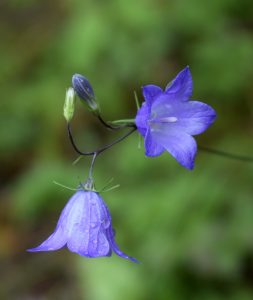Common Harebell
 Campanula rotundifolia, in the Bellflower family, is also known as the bluebell bellflower. We go way back, this flower and I, to my admiration of their beauty since I was a child. This native flower’s bloom time extends June through frost, and It’s always pleasant to come across its purple splashes of color growing just about anywhere. Harebell’s easily recognizable broad bells open slowly from bottom to top and ring their way upwards on a slender green stalk. They gracefully waving in the breeze from cottage gardens, and woodlands in sun or shade. A hardy plant, harebell grows in the barest of rocky soils to the varying soils of woods, fields, forests, meadows and even at high elevations.
Campanula rotundifolia, in the Bellflower family, is also known as the bluebell bellflower. We go way back, this flower and I, to my admiration of their beauty since I was a child. This native flower’s bloom time extends June through frost, and It’s always pleasant to come across its purple splashes of color growing just about anywhere. Harebell’s easily recognizable broad bells open slowly from bottom to top and ring their way upwards on a slender green stalk. They gracefully waving in the breeze from cottage gardens, and woodlands in sun or shade. A hardy plant, harebell grows in the barest of rocky soils to the varying soils of woods, fields, forests, meadows and even at high elevations.

Flowers appear as loose racemes on short stalks with a long style protruding form the center of the 5-pointed, slightly flaring lobes. Bees are important pollinators, although these flowers are also capable of self fertilization. Look on the underside of the ‘bell’ to find the calyx with 5 very thin, green sepals spreading outward from its short tube. Leaves are smooth edged and very slender, about 1/3 inch wide towards the bottom and narrowing even more as the leaves ascend the wiry stem alternately. The species names comes from the fact that the basal leaves are round in shape (as opposed to the grass-like upper leaves). Plants grow about 12″ tall.
A hanging fruit in the form a capsule with tiny seeds inside ripens brown to gray brown. You can scatter these seeds to propagate harebells, or divide existing plants into clumps in spring or fall. The leaves of this plant are edible; try tossing some into a salad for a nutritious dose of Vitamin C.
